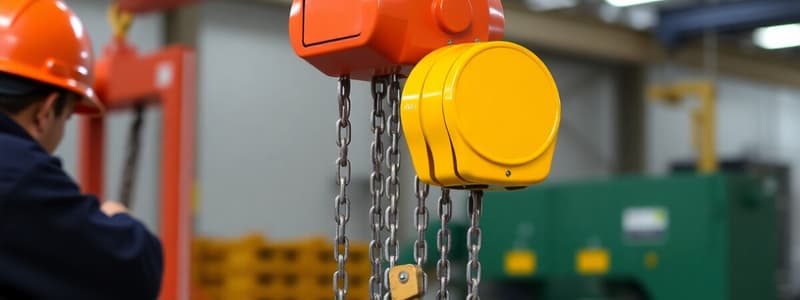Podcast
Questions and Answers
What is the primary difference between a crane fork and a C-hook?
What is the primary difference between a crane fork and a C-hook?
- Crane forks are fabricated from profiled plates, while C-hooks are made from rolled beam sections.
- Crane forks are used for lifting palletised loads, while C-hooks are used for hollow loads.
- Crane forks are generally more versatile, while C-hooks are typically designed for specific loads. (correct)
- Crane forks are typically used in permanent lifting facilities, while C-hooks are used in temporary applications.
What is a common application for powered lifting machines?
What is a common application for powered lifting machines?
- As part of an excavation system.
- As a standalone lifting device for highly specialized applications.
- As part of a larger lifting installation, like an overhead travelling crane. (correct)
- As a primary power source for construction equipment.
Which of the following is NOT a common type of power source for powered lifting machines?
Which of the following is NOT a common type of power source for powered lifting machines?
- Pneumatic
- Steam (correct)
- Electric
- Hydraulic
What is the main function of a crane fork?
What is the main function of a crane fork?
Why are crane forks and C-hooks considered together, despite their design differences?
Why are crane forks and C-hooks considered together, despite their design differences?
In what scenarios are hand-operated chain hoists commonly used?
In what scenarios are hand-operated chain hoists commonly used?
What is the primary purpose of the chain end stop on a hand-operated chain hoist?
What is the primary purpose of the chain end stop on a hand-operated chain hoist?
How do advancements in material and manufacturing technologies influence hand-operated chain hoists?
How do advancements in material and manufacturing technologies influence hand-operated chain hoists?
What mechanism transmits the power in a hand-operated chain hoist?
What mechanism transmits the power in a hand-operated chain hoist?
How are combined types of hand-operated chain hoists typically configured?
How are combined types of hand-operated chain hoists typically configured?
What is the primary function of the automatic brake found in modern hand-operated hoists?
What is the primary function of the automatic brake found in modern hand-operated hoists?
What is the difference between lower capacity and higher capacity hand-operated chain hoists?
What is the difference between lower capacity and higher capacity hand-operated chain hoists?
What is the primary advantage of using a lever hoist?
What is the primary advantage of using a lever hoist?
What type of chain is often used in a lever hoist?
What type of chain is often used in a lever hoist?
What is the function of the 'change-over lever' on a lever hoist?
What is the function of the 'change-over lever' on a lever hoist?
What is the primary purpose of the 'chain end stop' on a lever hoist?
What is the primary purpose of the 'chain end stop' on a lever hoist?
What is a common alternative name for a 'jaw' or 'creeper' winch?
What is a common alternative name for a 'jaw' or 'creeper' winch?
What is a significant characteristic of 'jaw' or 'creeper' winches?
What is a significant characteristic of 'jaw' or 'creeper' winches?
What is the reason for the lower factor of safety when using a jaw or creeper winch for pulling compared to lifting?
What is the reason for the lower factor of safety when using a jaw or creeper winch for pulling compared to lifting?
Which of the following is NOT a typical characteristic of a lever hoist?
Which of the following is NOT a typical characteristic of a lever hoist?
What is the primary function of the keys in a jaw winch?
What is the primary function of the keys in a jaw winch?
Why is it essential to use only manufacturer-approved ropes with a specific jaw winch?
Why is it essential to use only manufacturer-approved ropes with a specific jaw winch?
What happens if a rope with a diameter that is too small is used with a jaw winch?
What happens if a rope with a diameter that is too small is used with a jaw winch?
What is the purpose of the tapered and fused end of the load rope in a jaw winch?
What is the purpose of the tapered and fused end of the load rope in a jaw winch?
What is the primary function of the non-return valves in a hydraulic jack?
What is the primary function of the non-return valves in a hydraulic jack?
What happens when the oil in a hydraulic jack is forced through the non-return valves?
What happens when the oil in a hydraulic jack is forced through the non-return valves?
How is the load lowered in a hydraulic jack?
How is the load lowered in a hydraulic jack?
Which of the following materials is NOT commonly used in the manufacture of hydraulic jack bodies?
Which of the following materials is NOT commonly used in the manufacture of hydraulic jack bodies?
In which type of mechanical jack does the operator directly carry the load during the jacking operation?
In which type of mechanical jack does the operator directly carry the load during the jacking operation?
What type of mechanical jack utilizes a bevel gear and screw mechanism?
What type of mechanical jack utilizes a bevel gear and screw mechanism?
What is the purpose of the pawls in a ratchet jack?
What is the purpose of the pawls in a ratchet jack?
What is the purpose of the swivel head in a screw jack?
What is the purpose of the swivel head in a screw jack?
What is the function of the running nut in a journal jack?
What is the function of the running nut in a journal jack?
What is the difference between a ratchet jack and a screw jack?
What is the difference between a ratchet jack and a screw jack?
Which of the following is NOT a type of mechanical jack mentioned in the text?
Which of the following is NOT a type of mechanical jack mentioned in the text?
Which type of mechanical jack can have the full rated load supported either on the head or toe?
Which type of mechanical jack can have the full rated load supported either on the head or toe?
Flashcards
Crane Forks
Crane Forks
Devices used to lift palletized loads directly from a crane hook.
C-Hooks
C-Hooks
Hooks designed to lift hollow loads like pipes or coils from a crane hook.
Powered Lifting Machines
Powered Lifting Machines
Electric or pneumatic devices used in industrial lifting operations.
Electric Operation
Electric Operation
Signup and view all the flashcards
Temporary Lifting Facility
Temporary Lifting Facility
Signup and view all the flashcards
Mechanical Jacks
Mechanical Jacks
Signup and view all the flashcards
Ratchet Jack
Ratchet Jack
Signup and view all the flashcards
Pawls
Pawls
Signup and view all the flashcards
Rack
Rack
Signup and view all the flashcards
Screw Jack
Screw Jack
Signup and view all the flashcards
Swivel Head
Swivel Head
Signup and view all the flashcards
Journal Jack
Journal Jack
Signup and view all the flashcards
Bevel Gear
Bevel Gear
Signup and view all the flashcards
Jaw Winch Operation
Jaw Winch Operation
Signup and view all the flashcards
Components of Jaw Winch
Components of Jaw Winch
Signup and view all the flashcards
Rope Diameter Importance
Rope Diameter Importance
Signup and view all the flashcards
Manufacturer Approved Ropes
Manufacturer Approved Ropes
Signup and view all the flashcards
Hydraulic Jack Materials
Hydraulic Jack Materials
Signup and view all the flashcards
Hydraulic System Function
Hydraulic System Function
Signup and view all the flashcards
Lifting and Lowering Mechanism
Lifting and Lowering Mechanism
Signup and view all the flashcards
Hydraulic Ram
Hydraulic Ram
Signup and view all the flashcards
Lever Hoist
Lever Hoist
Signup and view all the flashcards
Versatile Tool
Versatile Tool
Signup and view all the flashcards
Adjustable Sling Leg
Adjustable Sling Leg
Signup and view all the flashcards
Types of Lever Hoists
Types of Lever Hoists
Signup and view all the flashcards
Pocketed Wheel
Pocketed Wheel
Signup and view all the flashcards
Hand Chain
Hand Chain
Signup and view all the flashcards
Creeper Winches
Creeper Winches
Signup and view all the flashcards
Working Load Limit
Working Load Limit
Signup and view all the flashcards
Manual Chain Hoists
Manual Chain Hoists
Signup and view all the flashcards
Applications of Chain Hoists
Applications of Chain Hoists
Signup and view all the flashcards
Pocketed Wheel Function
Pocketed Wheel Function
Signup and view all the flashcards
Automatic Brake Mechanism
Automatic Brake Mechanism
Signup and view all the flashcards
Single Fall Hoists
Single Fall Hoists
Signup and view all the flashcards
Multiple Fall Hoists
Multiple Fall Hoists
Signup and view all the flashcards
Combined Hoists
Combined Hoists
Signup and view all the flashcards
Study Notes
Hand Operated Chain Hoists
-
Manual chain hoists are common globally, useful in various applications, including:
- Permanent installations for infrequent use
- Temporary setup for erection/maintenance
- Precise load positioning
- Where power isn't available
-
Technological advancements resulted in smaller, lighter, and more efficient hoists.
-
Hoist operation involves a pocketed wheel for the load chain to freely enter and leave, and a mechanism of hand chain and screw brake to drive the wheel.
-
A chain stop prevents the load chain from falling.
-
Modern hoists have automatic brakes, halting and holding the load at any position.
Attachment
-
Hoists come in suspended or combined unit models.
-
Suspended hoists use attachments (like hooks, shackles, eyebolts) to be hung, offering varied articulation.
Lower Capacity Hoists
- Lower capacity hoists (e.g., 500 kg, 1 ton) lift the load using a single load chain.
Higher Capacity Hoists
-
Higher capacity models may feature larger frames or multiple load chain falls.
-
Some high-capacity hoists include multiple frames linked via a yoke.
Hand Operated Lever Hoists
-
Lever hoists provide versatile lifting and pulling capabilities for rigging and balancing loads.
-
They come in different types, utilizing either calibrated short link steel chain or roller chains for operation.
-
Advances in materials facilitate smaller, lighter, improved models.
-
The pocketed wheel, driven by a hand chain and screw brake mechanism, is a key feature.
-
A change-over lever sets the chain length.
-
A chain end stop avoids load chain passage.
Lifting and Pulling Machines - Using Gripping Action on Wire Rope
-
Jaw/creeper winches are used for lifting and pulling in various situations, often with temporary or permanent rigging applications, potentially with a lower safety factor for pull-based work.
-
These are commonly manual, though hydraulic versions are also available.
-
Hydraulic versions often rely on link to an external hydraulic pump.
All Jaw Winches
-
Jaw winches use levers and cams on keys to grip or release wire rope for operating.
-
The rope diameter is critical for effective operation; ropes must match the winch's specifications to ensure efficiency and safety.
-
The rope should be as integral to the winch mechanism as a chain is to a chain hoist.
-
Load rope entry is via a plain tapered section.
Hydraulic Jacks
-
Hydraulic jacks are commonly made of aluminum and steel/cast iron; material selection influences design, weight and capacity
-
They rely on oil within the jack body or reservoir.
-
Hydraulic operation lifts/lowers the load by controlled oil movement through non-return valves into or out of the ram.
Mechanical Jacks
-
Various mechanical jack types (ratchet, screw, journal) offer load lifting/lowering capabilities.
-
The specific jack parts and methods of operation slightly differ between the various types
Crane Forks and 'C' Hooks
-
Crane forks and 'C' hooks lift loads directly without further attachments from crane hooks.
-
C-hooks are typically designed for specific loads.
-
Crane forks are typically used in more general-lifting situations.
-
The different types are often used in similar situations and can be grouped together when analyzing
Powered Lifting Machines
-
Electrically or pneumatically operated lifting machines are widespread in the industry.
-
Their speed and reduced worker fatigue make them highly suitable, especially for repetitive tasks, that may require workers to be separate from the load.
Studying That Suits You
Use AI to generate personalized quizzes and flashcards to suit your learning preferences.




